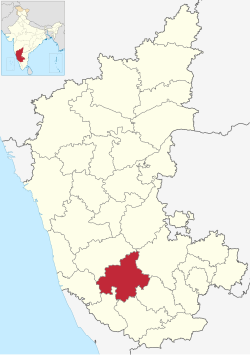Hassan district
|
Hassan district ಹಾಸನ ಜಿಲ್ಲೆ ಮಲೆನಾಡು , MaleNadu |
|
|---|---|
| district | |

Lakshmi Narasimha Temple 1246 Trikuta architecture, Nuggihalli
|
|
 Location in Karnataka, India |
|
| Coordinates: 13°N 76°E / 13°N 76°ECoordinates: 13°N 76°E / 13°N 76°E | |
| Country |
|
| State | Karnataka |
| Headquarters | Hassan |
| Talukas | Hassan, Holenarsipur, Arkalgud, Channarayanapatana, Sakleshpur, Belur, Alur, Arasikere |
| Languages | |
| • Official | Kannada |
| Time zone | IST (UTC+5:30) |
| PIN | 573201 |
| Telephone code | 08172 |
| Vehicle registration | KA-13, KA-46 |
| Website | www |
Hassan is a district in Karnataka state, India. The district headquarters are Hassan.
Hassan district was the seat of the Hoysala Empire which at its peak ruled large parts of south India from Belur as its early capital and Halebidu as its later capital during the period 1000 - 1334 CE.
The place is called Hassan after the Goddess "Haasanamba", the goddess and presiding deity of the town. The history of Hassan district is essentially the history of two of the well known dynasties that have ruled Karnataka, the Western Ganga Dynasty of Talkad (350 - 999 CE) and the Hoysala Empire (1000 - 1334 CE). In the 15th and 16th centuries, the Vijayanagar kings patronised Chennakesava of Belur as their family deity. It was also ruled by Adilshahis of Bijapur and Mughal Empire after decline of the Vijayanagar. In the 17th and 18th centuries, Hassan became a land of contention between the Keladi Nayakas of Shimoga and the Mysore Kingdom. It finally merged as an independent Mysore kingdom.
Around 300 BCE Hassan was part of the Mauryan empire. Sage Bhadrabahu arrived from north India in the 3rd century BCE along with many ascetics marking the arrival of Jainism into Karnataka.
Later Hassan came under the rule of the Ganga Dynasty of Talkad. The Gangas initially ruled as a sovereign power from 350 - 550 CE and later continued to rule this area as feudatories of Chalukyas and Rashtrakutas. In the late 10th century, many Jaina monuments were built at Shravanabelagola. Some of them, including the fifty seven feet tall monolithic statue of Gomateshwara, was commissioned by Ganga general Chamundaraya.
...
Wikipedia
